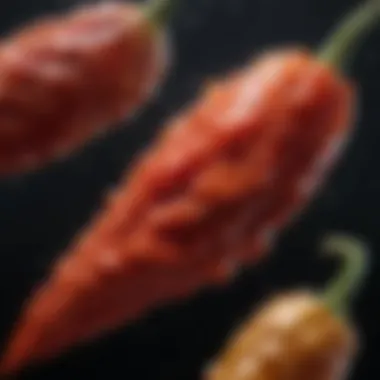How Hot Are Ghost Peppers? An In-Depth Exploration


Intro
Ghost peppers, scientifically known as Capsicum chinense, have gained notorious fame in recent years, primarily for their staggering heat levels. With a Scoville Heat Unit (SHU) ranking that often surpasses 1,000,000, they are considered one of the hottest peppers globally. This article aims to deeply explore not just the heat profile of ghost peppers, but also their unique characteristics, culinary uses, and health implications.
Beyond just a simple ingredient, ghost peppers embody a rich cultural heritage, particularly in regions like India where they are integral to local cuisine and tradition. Understanding ghost peppers involves a multifaceted approach; from their growing conditions to the variations in heat among different cultivars, there is a depth of knowledge to uncover.
Prepare to immerse yourself in this exploration of ghost peppers, gaining insights that range from safe handling practices and preparation methods to the fascinating way they can elevate dishes with their distinct flavor alongside their intense heat.
Understanding Ghost Peppers
The exploration of ghost peppers holds significant relevance in both culinary and cultural contexts. These peppers, known for their extreme heat and vibrant flavor, challenge many who are curious about spicy ingredients. Understanding ghost peppers goes beyond just acknowledging their heat levels; it involves delving into their characteristics, historical significance, and their culinary roles.
Key Elements of Ghost Peppers:
- Capsaicin Content: The chemical compound that gives ghost peppers their intense spiciness.
- Flavor Profile: While heat is a major aspect, ghost peppers also possess a unique taste that pairs well with various cuisines.
- Culinary Utility: Chefs and home cooks alike experiment with ghost peppers to add both heat and depth to dishes.
Recognizing these aspects promotes a deeper appreciation for ghost peppers, allowing food enthusiasts to make informed choices on how to incorporate them in cooking.
What Are Ghost Peppers?
Ghost peppers, scientifically known as Bhut Jolokia, are among the hottest chili peppers in the world. They originate from India, particularly in the northeastern regions. Ghost peppers have a vibrant red or orange appearance and are typically wrinkled, which contributes to their distinctive look.
They are rated around 1,000,000 Scoville Heat Units (SHU), which makes them significantly hotter than jalapeños, which typically score between 2,500 and 8,000 SHU.
The term “ghost pepper” is thought to derive from a local name, reflecting the fruit's fierce reputation. They not only provide a heat sensation but also carry a fruity flavor, making them versatile in various dishes.
Historical Context
The history of ghost peppers is rich and intertwined with regional cultures in India. Historically, their use can be traced back hundreds of years. They have been cultivated in the Assam region and are integral to local dishes, serving as both a spice and a preservative.
Cultural Importance:
- Medicinal Uses: Indigenous tribes have traditionally recognized the medicinal properties associated with ghost peppers. Their heat is thought to offer benefits in treating certain ailments.
- Agricultural Practices: The cultivation of these peppers has led to specific agricultural methods, preserving traditional farming practices within the region.
- Global Spread: In recent years, ghost peppers gained international attention, contributing to a growing interest in hot peppers worldwide.
Ghost peppers not only embody culinary interest but also serve as a representation of local practices and history, extending their significance beyond the kitchen.
Scoville Heat Units: Measuring Heat
Understanding the heat of ghost peppers involves a critical grasp of Scoville Heat Units (SHU). This measurement serves not only as a tool for gauging the heat in chili peppers but also has significance in culinary applications. Knowing the SHU of ghost peppers is crucial for chefs and food lovers who wish to include these potent peppers in their cooking mindfully. The heat level impacts flavor profiles and potential health effects, which makes this information essential for both enjoyment and safety.
What Are Scoville Heat Units?
Scoville Heat Units are a quantifiable metric that reflects the pungency or heat of chili peppers. It relies on the concentration of capsaicin, a compound responsible for the fiery sensation that peppers produce. In basic terms, the scale was developed by Wilbur Scoville in 1912, who conducted tests to evaluate the heat levels based on human taste perception.
SHU is determined through a method known as the Scoville Organoleptic Test, where a panel of humans tastes a solution of the sample pepper diluted in sugar water until the heat becomes undetectable. The resulting dilution level determines the SHU; for instance, a pepper that requires 10,000 times dilution for the heat to disappear would rank at 10,000 SHU. This system, while rudimentary, sets the groundwork for understanding chilies.
Ghost Pepper's Ranking


Ghost peppers, scientifically known as Capsicum chinense, are among the hottest peppers in the world. Their SHU typically ranges from 855,000 to over 1,000,000 units. This rating firmly places them in the realm of extreme heat. Such levels surpass significantly many commonly used peppers, making ghost peppers a key ingredient in spicy dishes.
The ghost pepper held the Guinness World Record for the hottest pepper from 2007 until it was overtaken by other cultivars, such as the Carolina Reaper. Nevertheless, the ghost pepper remains a prominent choice in the world of spicy cuisine due to its distinct flavor and heat that challenges even the most seasoned chili aficionados.
Comparison with Other Peppers
The Scoville scale allows for comparative analysis between ghost peppers and other popular chili varieties. For example:
- Bell Pepper: 0 SHU
- Jalapeño: 2,500 - 8,000 SHU
- Serrano: 2,500 - 5,000 SHU
- Habanero: 100,000 - 350,000 SHU
- Carolina Reaper: 1,400,000 - 2,200,000 SHU
As observed, ghost peppers fall uniquely high on the scale. In contexts of usage, the comparison establishes distinct culinary roles. For chefs, understanding these differences is vital. A dish that only requires a hint of heat may benefit from a jalapeño, while a dish aiming for boldness could incorporate ghost peppers successfully.
Consideration: The use of ghost peppers should be handled with caution, especially for individuals unaccustomed to high heat levels. Always start with small quantities to gauge the heat produced in dishes.
Culinary Uses of Ghost Peppers
Understanding the culinary potential of ghost peppers is crucial for anyone interested in this intense chili. These peppers offer unique opportunities for exploration in flavors and heat levels. They can transform a dish, infusing it with not just heat but also a distinct, smoky character. Incorporating ghost peppers into recipes can elevate the overall taste profile of various meals. However, caution is necessary due to their extreme spiciness.
Incorporating Ghost Peppers into Recipes
When it comes to integrating ghost peppers into cooking, moderation is key. Their heat can quickly overpower a dish, so it is advisable to start with small amounts. Here are some ways to utilize ghost peppers in recipes:
- Sauces and Salsas: Ghost peppers can add depth to sauces. A small amount can enhance the flavor of classic tomato sauces. In salsas, they provide a tantalizing kick, making the dish more interesting.
- Marinades for Proteins: A ghost pepper infusion in marinades can help match the bold flavors of meats. Combining ghost pepper with oils or yogurt can create an excellent base for marinating chicken or fish.
- Spicy Soups: Adding ghost peppers to soups can elevate their heat. Be sure to simmer them thoroughly to release their flavor without overwhelming the stew.
- Drinks: Spicy cocktails are gaining popularity. Ghost peppers can be used in small quantities in drink recipes to create a unique spiced cocktail.
When preparing dishes, always consider the heat level. Providing a balanced flavor alongside the heat will result in a more enjoyable experience.
Ghost Peppers in International Cuisines
Ghost peppers have found their place in various international cuisines. Their versatility allows for experimentation and integration into different cooking styles. Here are a few culinary traditions that often use ghost peppers:
- Indian Cuisine: In India, ghost peppers are referred to as Bhut Jolokia. They are often used in chutneys and curries. Their heat is essential to many regional dishes.
- Southeast Asian Dishes: Countries like Thailand and Bangladesh incorporate ghost peppers for their spice level in traditional dishes like curries and stews.
- Caribbean Flavors: In Caribbean cooking, ghost peppers lend a fiery kick to hot sauces and marinades, enhancing the bold taste of grilled meats.
Utilizing ghost peppers in various cuisines allows chefs and home cooks alike to explore new dimensions of flavor. The adaptability of ghost peppers can give familiar dishes a delightful twist that may surprise the palate. However, always remember to adjust the quantities according to your heat tolerance to ensure a delightful dining experience.
Health Implications of Consuming Ghost Peppers
Understanding the health implications of consuming ghost peppers is essential for anyone who wants to explore the spiciness of this remarkable chili. While the ghost pepper provides intense heat and distinctive flavor, it is crucial to know the effects it can have on the body. This section will shed light on its nutritional profile, potential health benefits, and risks associated with high consumption.
Nutritional Profile
Ghost peppers, like many chilies, contain a variety of nutrients that contribute to their health profile. A standard serving of ghost peppers is low in calories but rich in vitamins. They are particularly notable for their content of vitamin C and vitamin A.
Additionally, they offer a good supply of potassium, which is important for heart health and maintaining proper muscle function. Here are some key aspects of the nutritional profile of ghost peppers:
- Low Calories: A serving has very few calories, typically around 18 calories per ounce.
- Vitamins: High in vitamin C, which boosts the immune system, and vitamin A, beneficial for vision.
- Minerals: Good source of potassium and iron, both essential for various bodily functions.
Consuming ghost peppers can complement a balanced diet, provided that moderation is practiced.
Potential Health Benefits


Ghost peppers offer various health advantages that can complement their culinary use. Here are several notable benefits of including ghost peppers in your diet:
- Anti-inflammatory Properties: Capsaicin, the active compound in ghost peppers, has anti-inflammatory effects, which may assist in reducing inflammation in the body.
- Pain Relief: Some studies suggest that capsaicin can help in minor pain relief, as it blocks pain signals to the brain.
- Metabolism Boost: Regular consumption may enhance metabolism, potentially aiding in weight loss efforts.
- Rich in Antioxidants: The antioxidants present in ghost peppers can help combat oxidative stress, contributing to overall health.
- Improved Heart Health: The nutrients and compounds in ghost peppers can promote cardiovascular health.
"Capsaicin offers health benefits, but moderation is key to avoiding discomfort."
While these benefits may be promising, it is important to approach consumption with prudence and awareness of individual tolerance levels.
Risks Associated with High Consumption
Despite the various health benefits, consuming ghost peppers in excess can lead to significant discomfort and health issues. Here are some risks to consider:
- Digestive Issues: Consuming ghost peppers can lead to stomach pain, gas, and diarrhea if eaten in large amounts.
- Burning Sensation: Capsaicin can cause a burning sensation in the mouth and throat, leading to distress, particularly in less tolerant individuals.
- Risk of Overconsumption: High consumption can lead to a condition called capsaicin intolerance, which may cause long-term digestive problems for some individuals.
- Interactions with Medications: Hot peppers might interact with certain medications, including blood thinners or anti-inflammatories, leading to adverse effects.
Some individuals have a higher tolerance to spice, while others may experience discomfort even with small amounts of ghost pepper. As with any food, it is prudent to listen to your body and consult with a healthcare provider if unsure about including ghost peppers in your diet.
Cultural Significance of Ghost Peppers
The cultural relevance of ghost peppers extends far beyond their extreme heat. These peppers are often a symbol of regional pride, particularly in India where they originate. Ghost peppers are also referred to as Bhut Jolokia in their native region. The pepper's intensity is not just about the spice; it represents tradition, identity, and community.
Their role in rituals and customs is significant. In many cultures, especially in Northeast India, ghost peppers are incorporated into religious offerings and ceremonies. They are believed to ward off evil spirits and ensure good fortune. This spiritual aspect adds a layer of depth to their culinary use.
Furthermore, ghost peppers have a considerable presence in popular culture. They feature in various cooking shows and competitive eating events, showcasing not only the thrill of heat but the ingenuity of culinary arts. They captivate those who not only seek to taste but also to experience a challenge that brings communities together through shared culinary adventures. With their growing popularity, ghost peppers have sparked interest in planting and agricultural initiatives, which have energized local economies.
"These peppers blend pain with pleasure, making them symbols of both suffering and joy in culinary experiences."
Ghost Peppers in Folklore
In folklore, ghost peppers appear as symbols of strength and bravery. Many tales narrate how consuming these peppers signifies courage against adversity. In rural communities, tales spread about individuals embarking on daring feats after consuming these fiery peppers. They celebrate the notion that one can conquer challenges with the same resolve it takes to eat a ghost pepper.
The stories often emphasize communal gatherings, where the act of eating ghost peppers becomes a rite of passage. Elders share these tales during social events, connecting generations. This adds to the peppers’ allure, as they transcend mere gastronomy into cultural legacy.
Culinary Festivals and Competitions
Culinary festivals celebrating ghost peppers have gained popularity in various countries. These events showcase the versatility of ghost peppers in diverse dishes, ranging from salsas to sauces. Competitions often include spicy food challenges, which attract participants eager to test their limits. The thrill of competition fosters a sense of camaraderie among participants and spectators alike.
These festivals not only serve as platforms to highlight culinary creativity but also promote local producers. The exposure helps in sustaining agricultural practices and invigorating local economies. Food lovers from all walks of life converge in these gatherings, creating vibrant atmospheres that celebrate the ghost pepper's cultural significance alongside its culinary capabilities.
Handling and Preparing Ghost Peppers
Handling and preparing ghost peppers is crucial for experiencing their full flavor and heat safely. These peppers offer a unique kick to various dishes, but their intense heat can also lead to discomfort if mishandled. Understanding safe practices and proper techniques is essential for anyone looking to incorporate ghost peppers into their cooking. This section examines both the safety and preparation aspects in detail.
Safe Handling Practices
When dealing with ghost peppers, safety should be the top priority. Their high capsaicin content can lead to severe irritation on skin and mucous membranes. Here are some essential practices to follow:
- Use gloves: Always wear disposable gloves when handling ghost peppers. This prevents skin contact with the oils that cause the burning sensation.
- Avoid touching your face: One should not touch their face, especially the eyes, after handling ghost peppers. If contact occurs, wash your hands thoroughly.
- Work in a well-ventilated area: Mild fumes can be released while chopping or cooking with ghost peppers. Good ventilation helps minimize exposure.
- Keep away from children and pets: Store ghost peppers out of reach to avoid accidental ingestion or contact.


Capsaicin can be so potent that it remains on surfaces like cutting boards and knives, necessitating thorough cleaning to remove residue.
By adhering to these practices, the risk of an unpleasant experience is significantly reduced.
Preparation Techniques
Preparing ghost peppers requires diligence and care. The following techniques can help manage their heat while maximizing flavor:
- Removing seeds and membranes: The seeds and white membranes contain a large concentration of capsaicin. Removing them can drastically reduce the pepper's heat. To do this, slice the pepper open lengthwise, scoop out the seeds, and remove the inner white membranes with a knife.
- Chopping or blending: After deseeding, chop or blend the peppers according to your recipe. This releases the essential oils and flavors. When using a blender, ensure it is well-sealed, as the fumes may escape.
- Marinating: Marinating ghost peppers in vinegar or a citrus juice can help mellow their heat. This technique is especially effective when used in salsas or sauces.
- Cooking methods: Roasting or grilling ghost peppers can alter their flavor profile. The heat may become more complex, allowing for a richer taste. Add the roasted peppers to dishes to enjoy their distinct flavor without overwhelming heat.
Ghost Pepper Varieties and Their Heat Levels
Understanding ghost pepper varieties is crucial for both enthusiasts and culinary experts. The different cultivars can exhibit significant variances in heat levels and flavor profiles. Ghost peppers are not only known for their intense heat but also for diverse tastes, which can enhance various dishes in unique ways. Recognizing these differences can inform cooking methods and safety precautions. It is important to choose the right variety for intended use, whether it is for culinary endeavors or personal spice tolerance.
Different Cultivars of Ghost Peppers
Ghost peppers, or Bhut Jolokia, have various cultivars that each showcase distinct characteristics. Some of the most notable varieties include:
- Bhut Jolokia (Standard): This is the most recognized type that helped establish the ghost pepper's fame. Its Scoville Heat Unit (SHU) rating ranges from 800,000 to over 1 million. The heat is immediate but not burning, and there is a notable fruity undertone.
- Chocolate Bhut Jolokia: This variant has a unique brownish color. It's often said to have a sweeter flavor with a similar heat level to the standard Bhut Jolokia. Its darker hue makes it an intriguing addition to dishes.
- White Bhut Jolokia: Slightly milder than its counterpart, this variant offers a unique visual appeal and a hint of floral notes. It still provides significant heat, making it suitable for adventurous eaters who desire depth in flavor.
- Red Bhut Jolokia: This cultivar tends to be a bit hotter, often reaching upwards of 1,001,304 SHU. It also tends to be more popular, adding vibrant color to dishes without compromising on the signature ghost pepper burn.
These cultivars illustrate that not all ghost peppers are created equal. Understanding these differences can aid in selecting the right pepper for specific culinary needs or heat preferences.
Regional Variations in Heat
Heat levels can also vary significantly based on the region where the ghost peppers are grown. Factors such as soil quality, climate, and cultivation methods contribute to these variations. For example, ghost peppers cultivated in Assam, India, often display higher SHU values due to the unique growing conditions.
In contrast, ghost peppers grown in other countries, like the United States, may show slightly lower heat levels. This can happen because the farms may use different agricultural practices that affect the pepper's development.
It is not unusual for a single variety to have differing heat levels depending on where it is grown. This variability can create challenges for both growers and consumers trying to gauge the heat they will encounter.
"Understanding both the variety and origin of ghost peppers can significantly enhance culinary experiences."
In summary, the exploration of ghost pepper varieties and regional heat levels provides valuable insights into their complexity. This knowledge plays a vital role in culinary applications and contributes to a more informed approach to using grand ghost peppers.
The End: The Appeal of Ghost Peppers
The fascination surrounding ghost peppers extends beyond their intense heat. As we have explored in previous sections, ghost peppers offer a unique combination of flavors, culinary versatility, and cultural significance. These elements contribute to their growing popularity among food lovers and culinary enthusiasts.
Savoring the Challenge
For many, consuming ghost peppers is akin to a rite of passage in the culinary world. People often seek out the scorching heat not just for the thrill but also for the experience. This challenge can enhance social gatherings, inspiring friendly competitions and storytelling moments. Ghost peppers push limits and spark conversations, making meals memorable.
The sensation of consuming a ghost pepper can be exhilarating. Its heat lingers and creates a rush that spicy food aficionados relish. Nonetheless, it is essential to approach ghost peppers with respect and caution. Those unaccustomed to high levels of heat might find the experience overwhelming.
Embracing Culinary Adventures
Ghost peppers invite culinary creativity. Their intense flavor complements various dishes, encouraging experimentation in the kitchen. Chefs use ghost peppers in sauces, salsas, and marinades to elevate the taste and add depth.
Moreover, incorporating ghost peppers into recipes can transform ordinary meals into exceptional culinary experiences. They offer the opportunity to explore flavors from different cultures, highlighting how various cuisines utilize heat differently.
In summary, the appeal of ghost peppers lies in their ability to challenge our palates while inviting us to explore novel cooking possibilities. This dual nature makes them a beloved ingredient in kitchens worldwide. As we conclude this exploration of ghost peppers, it is clear that their significance goes beyond just heat. It encompasses tradition, innovation, and the joy of discovery in the culinary arts.
"The pursuit of heat in culinary experiences can lead to unexpected delights and new flavor profiles."
As we continue to embrace these adventures, ghost peppers are sure to retain their place at the heart of spicy cuisine.







